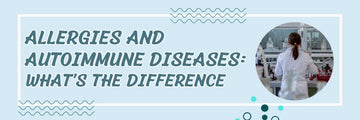Blog
The Hidden Allergies In Your Kitchen: Learn More on World Food Safety Day
by
Dr. Joseph Nightingale
on
Jul 06, 2024
World Food Safety Day is a global campaign to highlight the dangers of poor food safety. Worldwide, the main food safety risks involve infectious contamination, chemical hazards, and other foodborne risks. Such problems aren’t a major issue in Western nations. However, there is another aspect of food safety that goes underappreciated: food allergies and intolerances.
Unbeknownst to many people, their kitchen contains several food items that can spark an allergic reaction or slow-burning intolerance. In some people, the reactions can even be life-threatening.
So, this World Food Safety Day, let’s take a look at the hidden allergens in your kitchen – and what you can do about them.
Let’s Talk About Allergies and Intolerances
Over 50 years ago, the first wave of allergic disease began, triggering a surge in asthma and hay fever. More recently, the second wave began, with a sharp rise in people suffering from life-threatening food allergies.
In 2012,
1 in 40 children in the UK had at least one serious allergy. Whereas about
1 in 3 of the UK population (~20 million people) have some form of allergic disorder. According to the NHS, admissions for severe allergic reactions have more than doubled in the past twenty years.

When combined with the levels of food intolerances and sensitivities, we have an extremely problematic relationship with our kitchen pantries. Indeed, while food intolerances aren’t life-threatening, the symptoms can hamper your success.
Brain fog, headaches, muscle pains, skin rashes, and more harm your quality of life. Many people assume such symptoms are normal. It’s only when they eliminate the trigger foods from their life that they wonder how they ever coped.
Detecting Allergies and Intolerances
So, what’s the solution? For most people, the only long-term answer is to eliminate trigger foods from their diet. However, simply identifying the underlying cause is harder than you’d think. While certain foods are more likely to cause an allergy or intolerance, there are thousands of potential culprits.
According to the
UK Food Standards Authority, the 14 most common allergies include:
-
Cereals containing gluten - such as wheat, rye, barley, oats, spelt, or their hybridised strains.
-
Crustaceans - such as prawns, crabs, lobster, and crayfish.
-
Eggs - from chickens or other birds.
- Fish
- Peanuts
- Soybeans
-
Milk - including lactose.
-
Nuts - such as almonds, hazelnuts, walnuts, cashews, pecan nuts, Brazil nuts, pistachio nuts, and macadamia (or Queensland) nuts.
- Celery
- Mustard
- Sesame seeds
-
Sulphur dioxide and sulphites - at concentrations of more than 10 mg/kg or 10 mg/litre expressed as SO2.
-
Lupin - which includes lupin seeds and flour and can be found in types of bread, pastries and pasta.
-
Molluscs - such as mussels, clams, oysters, snails, and squid.
This list is an excellent place to start. But it won’t work for everyone. Keeping a
food diary is a sensible way to track your diet and symptoms. Look for patterns between symptoms and foodstuffs. That’s easier for allergies, as the reactions tend to occur immediately. Food intolerances, on the other hand, can cause a reaction up to 48 hours after ingestion.
Following your food diary, most people begin an
elimination diet. This involves removing all potential trigger foods from your diet. You can then reintroduce them one by one to see if the symptoms reappear. However, with dozens of potential culprits, it can take a long time.
Testing for Allergies and Intolerance
Both allergies and intolerances involve some kind of immune reaction to a foodstuff. In an allergy, the body wrongly flags the item as a pathogen, triggering an immediate immune response (an allergic reaction). Food intolerances are similar. Here, the body enters a pro-inflammatory state, hampering normal bodily functioning.
Antibodies are released in both conditions. IgE antibodies are most common in allergies, whereas IgG4 antibodies are associated with an intolerance.
We can test for levels of antibodies for particular allergens. Based on these results, we can assess the likelihood you have a particular allergy or intolerance. For example, our Allergy & Intolerance Test Plus screens for 117 common allergies and intolerances (38 allergies and 79 intolerances).
Why don’t you give it a go this World Food Safety Day?
Creating an Intolerance-Safe Kitchen
Once you’ve identified the trigger foods, you’ll want to remove them from your kitchen. Creating an intolerance-safe kitchen is essential for anyone suffering from food allergies or intolerances – especially if they’re life-threatening.
Follow these tips to keep your kitchen safe:
-
Separate Storage: Keep allergenic foods in separate, clearly labelled containers or shelves to avoid accidental mixing with allergen-free items.
-
Dedicated Utensils: Use separate cooking and serving utensils for allergenic and non-allergenic foods. Colour coding can help differentiate them easily.
-
Thorough Cleaning: Clean all surfaces, utensils, and appliances thoroughly after use to remove any traces of allergens. Consider using disposable cleaning cloths to avoid residue.
-
Ingredient Checks: Regularly read and re-read ingredient labels on all products, as manufacturers may change their recipes or processing methods.
-
Allergen-Free Substitutes: Stock up on allergen-free alternatives to ensure safe and inclusive cooking for everyone in the household.
Take an Allergy & Intolerance Test on World Food Safety Day
World Food Safety Day is a fantastic chance to take a closer look at your health. You could have allergies or intolerances that are ruining your quality of life. It doesn’t have to be that way!
Test Your Intolerance’s Allergy & Intolerance Test Plus is a home-to-lab test screening 117 common allergies and intolerances. You’ll receive a blood collection kit. Take a blood spot sample and send it back to us. We’ll test it in our lab, providing you with a comprehensive report.
Buy your test kit today! Take control of your health on World Food Safety Day.
 When combined with the levels of food intolerances and sensitivities, we have an extremely problematic relationship with our kitchen pantries. Indeed, while food intolerances aren’t life-threatening, the symptoms can hamper your success.
Brain fog, headaches, muscle pains, skin rashes, and more harm your quality of life. Many people assume such symptoms are normal. It’s only when they eliminate the trigger foods from their life that they wonder how they ever coped.
When combined with the levels of food intolerances and sensitivities, we have an extremely problematic relationship with our kitchen pantries. Indeed, while food intolerances aren’t life-threatening, the symptoms can hamper your success.
Brain fog, headaches, muscle pains, skin rashes, and more harm your quality of life. Many people assume such symptoms are normal. It’s only when they eliminate the trigger foods from their life that they wonder how they ever coped.














